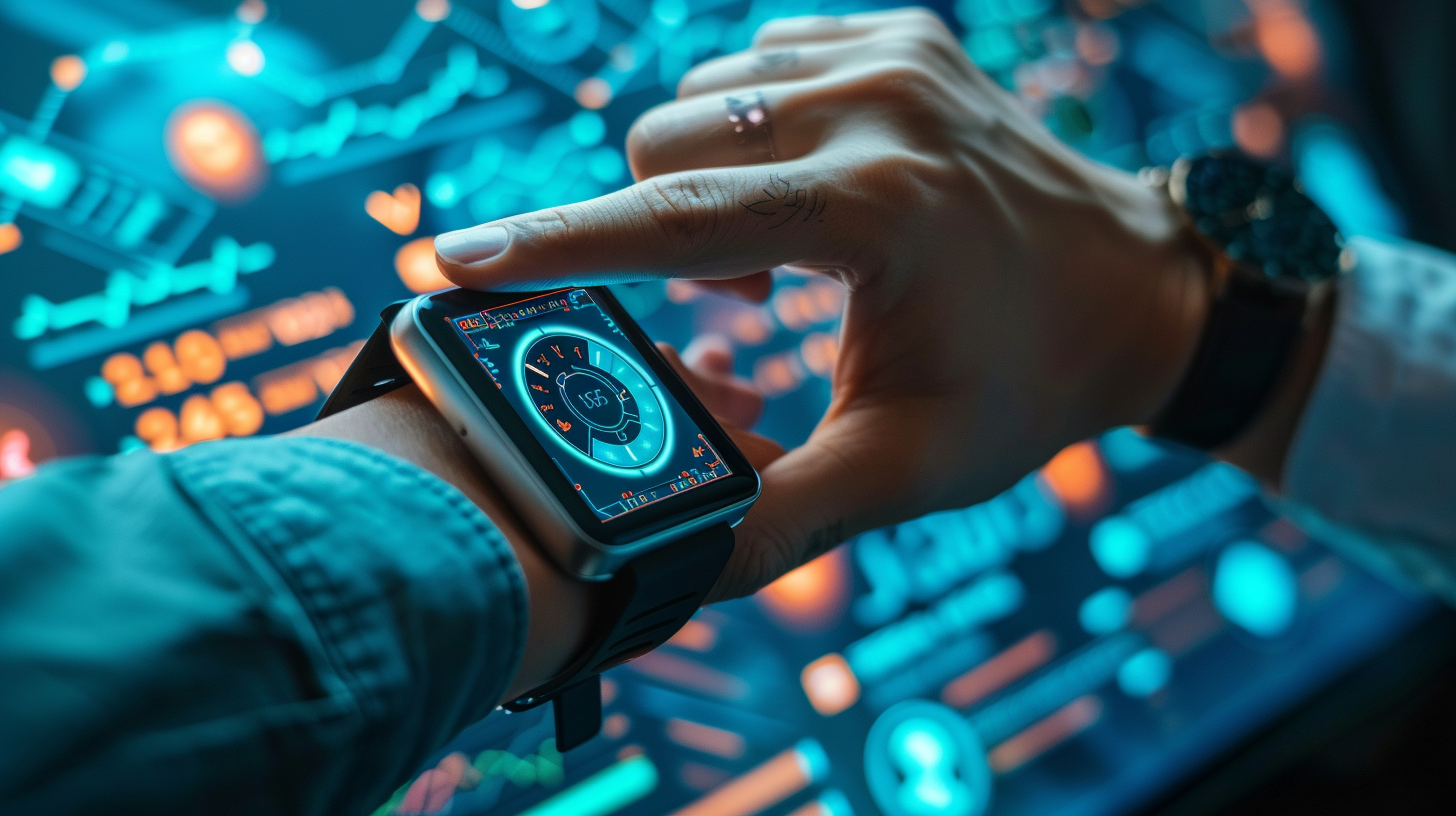Table of Contents Show
As the dawn of digital health breaks, we’re witnessing a seismic shift in healthcare delivery, thanks in large part to wearable technology. These devices are not just gadgets for the tech-savvy; they’re revolutionizing how we monitor essential signs, engage with our health, and even predict future medical issues. We’ve entered a new era where our health is literally in our hands, or more accurately, on our wrists. But as we stand on this frontier, questions about privacy, accuracy, and accessibility loom large. Join us as we explore how this technology is reshaping healthcare, and what that means for our future.
Key Takeaways
- Wearables offer continuous health monitoring, enabling early detection of potential health issues.
- Personalized health strategies and insights are crafted through data collected by wearable devices.
- Predictive analytics in wearables facilitate preventive care and tailored treatment plans for individuals.
- Integration with telehealth and compliance with data privacy regulations are vital for the advancement of wearable technology in healthcare.
The Rise of Wearables
Tracking our health has never been easier, thanks to the rapid ascent of wearable technology in recent years. We’re now living in an era where our desire for freedom and control over our own well-being is being met with innovative solutions. Wearable devices have revolutionized how we approach our daily lives, offering us the tools to make informed decisions about our lifestyle and activities without feeling tied down.
We’ve seen an explosion in the variety and capabilities of these devices. From fitness trackers that nudge us towards more active lifestyles to smartwatches that keep us connected without constantly reaching for our phones, we’re empowered to live more freely. We’re no longer just passive recipients of health advice; we’re actively engaged in managing our well-being, setting our own goals, and tracking our progress.
The convenience factor is undeniable. Wearables fit seamlessly into our lives, giving us insights on the go. Whether we’re looking to improve our sleep habits, manage stress, or simply stay active, there’s a device that caters to our needs. This technology has opened up new possibilities for personalized health strategies, tailored to fit our individual lifestyles, preferences, and goals.
Additionally, the social aspect of wearables can’t be overlooked. We’re sharing our achievements, challenging our friends, and finding community in our quest for better health. It’s this combination of personal empowerment and community support that truly exemplifies the freedom wearable technology brings into our lives.
Monitoring Vital Signs
Beyond enhancing our daily lives, wearable technology now offers the remarkable capability to monitor our essential signs in real time. This advancement empowers us with unprecedented control over our health, allowing us to track our physical condition with ease and precision. We’re no longer passive recipients of healthcare; instead, we’ve become active participants in managing our well-being.
Wearable devices, ranging from fitness trackers to smartwatches, can now continuously monitor a variety of crucial signs such as heart rate, blood pressure, and oxygen saturation. This means we can detect any anomalies early, well before they escalate into more serious health issues. It’s a proactive approach to health that places the power squarely in our hands.
| Essential Sign | Device Type | Benefit |
|---|---|---|
| Heart Rate | Fitness Tracker | Early detection of heart issues |
| Blood Pressure | Smartwatch | Monitors cardiovascular health |
| Oxygen Saturation | Specialized Sensor | Identifies potential respiratory problems |
| Sleep Patterns | Wearable Band | Improves overall health and mood |
These devices not only track our health metrics but also provide actionable insights, enabling us to make informed decisions about our lifestyle and activities. It’s a freedom that was unthinkable just a few decades ago, offering a personalized approach to health that fits seamlessly into our daily lives. As we continue to embrace this technology, we’re not just monitoring our health; we’re actively improving it, one heartbeat at a time.
Enhancing Patient Engagement
Moving beyond simple monitoring, we’re now exploring how wearable technology fosters greater patient engagement. Personalized health monitoring, motivating self-care practices, and seamless data sharing stand at the forefront of this evolution. These advancements not only empower patients but also revolutionize their interaction with healthcare systems.
Personalized Health Monitoring
Personalized health monitoring through wearable technology enhances patient engagement by providing real-time data and insights tailored to individual health needs. We’re seeing a revolution where users take control of their health journey, breaking free from the one-size-fits-all approach.
Here’s how:
- Custom Alerts: We receive notifications for irregularities, ensuring we’re always in the loop.
- Goal Setting: We set personal health goals, fostering a sense of autonomy.
- Progress Tracking: We monitor our achievements, celebrating every milestone.
- Feedback Loop: We get instant feedback, allowing for quick adjustments to our health regimen.
This approach empowers us to make informed decisions, leading to improved health outcomes and a deeper connection to our wellness journey, all while maintaining our cherished freedom.
Motivating Self-Care Practices
Wearable technology has revolutionized self-care practices, greatly boosting patient engagement and motivation. We’re now empowered to take control of our health in ways that fit our lifestyles, offering freedom to pursue wellness on our terms. This shift towards active participation in our health journey is a game-changer, making self-care not just necessary but also appealing.
| Feature | Benefit |
|---|---|
| Real-time Feedback | Encourages immediate action |
| Goal Setting | Fosters personal accountability |
| Social Sharing | Builds community support |
| Gamification | Makes health goals fun |
| Custom Alerts | Personalizes reminders |
These elements work in harmony to transform the mundane into the motivational, nudging us towards healthier habits and, ultimately, a sense of autonomy over our well-being. It’s about embracing freedom, one step at a time.
Seamless Data Sharing
Seamless data sharing substantially enhances patient engagement by ensuring that health information flows effortlessly between devices and healthcare providers. This freedom to access and share health data empowers us, letting us take control of our own health journey. Here’s how it transforms our experience:
- Instant Updates: We’re always in the loop, with real-time health data at our fingertips.
- Personalized Care: Our data enables tailored healthcare strategies, making treatment more effective and less intrusive.
- Empowered Decisions: With our health data accessible, we’re better equipped to make informed choices about our care.
- Enhanced Communication: It bridges the gap between us and our healthcare providers, ensuring we’re always on the same page.
This level of engagement liberates us, giving us the autonomy to manage our health proactively.
Predictive Health Analytics
As we turn our attention to predictive health analytics, it’s clear that wearable technology is at the forefront of revolutionizing healthcare. By harnessing predictive models in medicine, wearables are not just gadgets but tools that greatly improve patient outcomes. They enable us to make data-driven health decisions, marking a pivotal shift in how we approach healthcare.
Predictive Models in Medicine
Many healthcare advancements now hinge on the development of predictive models, which utilize data to forecast potential health outcomes. We’re excited about how these models empower us with insights, offering a leap towards personalized and preventive care. Here’s why they’re revolutionary:
- Early Detection: They flag risks before symptoms manifest, allowing for proactive intervention.
- Tailored Treatments: Predictive analytics help customize care plans, enhancing effectiveness.
- Resource Optimization: By predicting healthcare demands, they guarantee better allocation, saving time and resources.
- Empowered Decisions: With predictive insights, we gain control over our health journey, making informed choices about our care.
These models don’t just predict the future; they’re reshaping our approach to healthcare, making it more efficient, personalized, and, importantly, within our control.
Wearables Improving Patient Outcomes
In the domain of healthcare, wearable technology is revolutionizing patient care by harnessing predictive health analytics to improve outcomes. We’re entering an era where our watches, bands, and even clothes can predict health issues before they become serious. This isn’t just about counting steps or monitoring heart rates anymore; it’s about predicting potential health crises and intervening early. By wearing these devices, we’re not just passive recipients of healthcare; we’re active participants in our own well-being. This shift empowers us, giving us the freedom to manage our health proactively rather than reactively. It’s a game-changer, transforming the way we approach our health, and ultimately, helping us lead healthier, happier lives.
Data-Driven Health Decisions
Harnessing the power of predictive health analytics, wearable technology enables us to make informed, data-driven decisions about our health. This empowerment isn’t just liberating; it’s revolutionizing how we approach wellness. Here’s how:
- Early Detection: Devices predict potential health issues before they become serious, giving us the freedom to address them proactively.
- Personalized Insights: We receive recommendations tailored to our unique health profiles, ensuring that advice is relevant and actionable.
- Real-Time Monitoring: Continuous data collection offers us immediate feedback on our health status, allowing for quick adjustments.
- Long-Term Health Trends: Analyzing data over time uncovers patterns, helping us understand our health journey and make changes for a brighter future.
Embracing this technology, we’re not just patients; we’re active participants in our health care journey.
Remote Patient Monitoring
We’re seeing a significant shift towards Remote Patient Monitoring (RPM) through wearable technology, improving patient outcomes and healthcare efficiency. This surge isn’t just about convenience; it’s revolutionizing the way we approach healthcare freedom. With RPM, we’re no longer tied down to traditional hospital visits for routine check-ups or monitoring. Instead, we’re embracing a future where our health data comes to us, wherever we are.
This new frontier of healthcare allows us to live our lives with fewer interruptions. Wearable devices track vital signs, physical activity, and even sleep patterns, sending this data directly to healthcare providers in real-time. It’s like having a personal health guardian on your wrist, ensuring that any potential issues are caught early, without the need to step into a doctor’s office.
In addition, RPM empowers us with the knowledge of our own health metrics, turning us from passive recipients of healthcare into active participants. We can see the impact of lifestyle choices on our health metrics, nudging us towards healthier habits. This level of engagement is vital for a sense of autonomy over our well-being.
For healthcare providers, RPM offers a clearer, continuous picture of a patient’s health, reducing emergency visits and hospital readmissions. It’s a win-win situation. Providers can offer more personalized care, and we enjoy a greater sense of freedom and control over our health journey.
In short, RPM through wearable technology is not just a trend. It’s a pivotal shift towards a more liberated and empowered healthcare experience for all of us.
Impact on Chronic Diseases
Amidst the evolution of healthcare technology, wearable devices have emerged as a game-changer for managing chronic diseases. We’ve witnessed firsthand how these devices empower individuals, offering them the freedom to take charge of their health outside traditional healthcare settings.
Wearable technology has revolutionized our approach to chronic disease management in several key ways:
-
Real-time Monitoring: We no longer have to wait for periodic check-ups to understand our health status. Wearables provide continuous, real-time data on essential signs, allowing us to catch potential issues early and adjust our lifestyle or treatment plans accordingly.
-
Personalized Insights: These devices collect heaps of data tailored to our unique health profiles. By analyzing this data, we can uncover personal triggers for symptoms and identify what lifestyle changes could lead to better health outcomes.
-
Enhanced Communication with Healthcare Providers: The data collected can be shared with our doctors, making our appointments more efficient and focused. It’s like having a health diary at our fingertips; we can show rather than tell, leading to more personalized care.
-
Increased Autonomy: Perhaps most importantly, wearables give us a sense of control over our health. We’re not just passive recipients of care; we’re active participants, making informed decisions about our treatment and lifestyle.
In embracing wearable technology, we’re not just adapting to a new trend. We’re taking a significant step towards more personalized, proactive, and empowering healthcare. It’s about breaking free from the constraints of traditional healthcare and embracing a future where we’re in the driver’s seat of our health journey.
Wearables in Mental Health
We’re now turning our focus to the transformative role of wearables in mental health, particularly in monitoring mood fluctuations and enhancing therapy outcomes. These devices offer a new frontier for understanding and managing mental health conditions. By providing real-time data, wearables give both patients and therapists invaluable insights that can lead to more effective treatments.
Monitoring Mood Fluctuations
In the domain of mental health, wearable technology has revolutionized the way we monitor mood fluctuations. We’ve embraced these devices because they offer us the freedom to understand and manage our mental well-being in real-time. Here’s how they’re changing the game:
- Continuous Monitoring: Wearables track our emotional states throughout the day, identifying patterns we might miss.
- Stress Detection: They alert us when our stress levels rise, prompting us to take action before we’re overwhelmed.
- Sleep Quality Analysis: Understanding the link between sleep and mood, these devices help us improve our sleep patterns.
- Activity Correlation: By correlating physical activity with mood changes, wearables encourage us to move more, boosting our mental health.
This empowerment lets us take charge of our mental well-being like never before.
Enhancing Therapy Outcomes
Building on the foundation of monitoring mood fluctuations, wearables in mental health are now greatly enhancing therapy outcomes. These devices offer us the freedom to manage our mental wellness with precision, making therapy more personalized and effective. Here’s a glimpse at how they’re changing the game:
| Feature | Benefit | Impact on Therapy |
|---|---|---|
| Real-time tracking | Immediate mood assessment | Tailored therapy sessions |
| Sleep monitoring | Improved understanding of rest | Enhanced recovery plans |
| Stress detection | Early warning signs | Preventive interventions |
Data Security and Privacy
Many users of wearable technology in healthcare are concerned about how their personal data is safeguarded and who has access to it. We’re all seeking the freedom to improve our health without sacrificing our privacy. The balance between benefiting from these innovations and safeguarding our personal information is delicate, and we’re here to navigate this landscape together.
To tackle these concerns, we’ve adopted several strategies:
-
Data Encryption: We guarantee that all data transmitted from our wearable devices is encrypted. This means your health data is turned into a code during transmission, making it much harder for unauthorized parties to access.
-
User Consent: Before sharing any data, we always seek your explicit consent. You’re in control of what information you share and with whom. This empowers you to make informed decisions about your data.
-
Regular Security Audits: To stay ahead of potential threats, we conduct regular security audits. These checks help us identify and fix vulnerabilities, ensuring your data remains protected against emerging risks.
-
Anonymization of Data: Whenever possible, we anonymize your data. This means that your personal information is removed or altered to prevent identification. By doing so, we can use the data to improve our services while protecting your identity.
We’re committed to maintaining the highest standards of data security and privacy. It’s our responsibility to protect your information while you focus on achieving your health goals. Together, we can embrace the benefits of wearable technology without compromising our freedom and privacy.
Integration With Telehealth
Understanding the importance of data security and privacy paves the way for discussing how wearable technology integrates with telehealth to enhance healthcare delivery. We’re at a pivotal point where our health monitoring isn’t just confined to the four walls of a clinic or hospital anymore. Wearables, from fitness trackers to advanced medical devices, are revolutionizing the way we engage with our health professionals.
We’re witnessing a seamless integration where data from our wearables directly informs telehealth services. This means our doctors can keep an eye on our health metrics in real time, without us having to step out of our homes. It’s about bringing healthcare into our daily lives, making it more accessible and less intrusive. We’re talking about a future where our doctors can monitor our heart rates, sleep patterns, and even predict potential health issues before they become serious, all thanks to the data shared through these devices.
This integration empowers us with the freedom to manage our health proactively. It’s not just about reacting to illnesses anymore; it’s about prevention and maintaining a lifestyle that keeps those illnesses at bay. And when we do need to consult with a healthcare professional, we’re not starting from scratch. They already have our health data, making consultations more efficient and personalized.
In essence, the integration of wearable technology with telehealth is not just changing healthcare delivery; it’s transforming our relationship with our health. It’s giving us the freedom to live our lives with the confidence that we’re supported by a healthcare system that understands and adapts to our individual needs.
Future of Personalized Medicine
As we explore the future of personalized medicine, wearable technology stands at the forefront, promising a new era of healthcare tailored uniquely to each individual’s needs. This shift towards customization in medical care is not just a promising vision but a rapidly approaching reality, thanks to advancements in wearable devices. We’re on the cusp of a healthcare revolution where our personal health data, once elusive or difficult to track, will be at our fingertips, empowering us with the freedom to manage our health more proactively and precisely.
Here’s how wearable technology is paving the way for personalized medicine:
-
Continuous Health Monitoring: Wearable devices allow for 24/7 health monitoring, capturing critical data such as heart rate, sleep patterns, and physical activity. This ongoing stream of information provides a detailed health overview, enabling healthcare providers to tailor treatments to the individual’s specific health profile.
-
Early Disease Detection: With the ability to monitor subtle changes in our bodies, wearables can alert us to early signs of potential health issues, long before they become serious. This early detection grants us the freedom to take preemptive action and make informed decisions about our health.
-
Customized Treatment Plans: By analyzing the vast amounts of data collected, healthcare professionals can craft treatment plans that are truly personalized, improving the effectiveness of treatments and reducing the risk of adverse reactions.
-
Enhanced Patient Engagement: Wearable technology empowers us to take an active role in our healthcare journey. By providing instant access to our health data, we’re more inclined to make lifestyle changes and engage with our healthcare providers on a deeper level.
Challenges and Limitations
Despite the promising advancements in wearable technology for personalized medicine, we can’t ignore the challenges and limitations that accompany its widespread adoption. We’re forging ahead into a future where our health can be monitored in real-time, yet we must confront the obstacles that could slow us down.
One major hurdle is data privacy. We all cherish our freedom and the control over our personal information. Wearable devices collect vast amounts of data, and we must make sure this information is protected and not misused. There’s a fine line between utilizing data for health benefits and infringing on an individual’s privacy rights.
Another challenge lies in accessibility. Not everyone has the means to afford the latest wearable technology. We’re passionate about democratizing healthcare, but if only a select few can access these advancements, we’re falling short of that goal. It’s important we find ways to make these technologies available to everyone, regardless of their economic status.
Data accuracy is also a concern. For us to truly trust and rely on wearable technology, the data provided must be precise and reliable. Inaccuracies in health data can lead to misdiagnoses and inappropriate treatments, risking our freedom to make informed decisions about our health.
Lastly, there’s the issue of technological literacy. To fully benefit from wearable technology, users must understand how to operate these devices effectively. Without proper education and support, many may find themselves excluded from these health innovations.
We’re on a journey toward a healthier future, but it’s essential we navigate these challenges together, ensuring freedom and access for all.
Regulatory Considerations
Understanding the regulatory landscape is essential as we integrate wearable technology into healthcare systems. As we navigate the regulatory frameworks that ensure safety without stifling progress, it’s important to push for innovation and freedom in healthcare. Here are four key regulatory considerations that we’re addressing:
-
Compliance with Health Data Protection Laws: We’re ensuring that wearable technologies comply with laws like HIPAA in the U.S., which protect patient health information. It’s about maintaining user trust while fostering a space for technological freedom.
-
Medical Device Regulations: Many wearable technologies are classified as medical devices. We’re working to meet the stringent standards set by regulatory bodies like the FDA in the U.S. and the EMA in Europe. It’s a balance between innovation and compliance, ensuring that devices are both safe and effective.
-
Interoperability Standards: We’re advocating for and adopting standards that allow seamless communication between wearables and existing healthcare systems. This ensures that the data from wearables can be easily integrated, enhancing patient care without creating silos.
-
International Regulatory Variations: We’re navigating the complexities of global markets, understanding that regulations can vary significantly from one country to another. It’s about advocating for harmonization where possible, to allow for the free flow of health innovations across borders.
As we work within these regulatory frameworks, we’re committed to pushing the boundaries of what’s possible in healthcare while ensuring the safety and privacy of users. It’s a delicate balance, but one that we’re moving through with a clear vision for a future where wearable technology transforms healthcare delivery.
The Path Forward
Exploring the future, we’re dedicated to harnessing wearable technology to transform healthcare. We’re on the cusp of a revolution that promises more freedom and control over our health than ever before. With advancements in wearable tech, we’re not just dreaming about a future where health monitoring and management are seamlessly integrated into our daily lives; we’re actively building it.
Our path forward is clear. First, we’re focusing on making wearable devices more user-friendly. We’re stripping away complexity to offer solutions that anyone can use, regardless of their tech-savviness. This means intuitive interfaces, longer battery lives, and designs that fit effortlessly into your day-to-day life.
Next, we’re pushing for stronger partnerships between tech companies and healthcare providers. By working together, we can ensure that the data collected by wearables is not only accurate but also meaningful. This collaboration will enable personalized healthcare plans, tailored to the individual’s needs, lifestyle, and goals, fostering a sense of freedom and empowerment over one’s health.
Lastly, we’re advocating for policies that protect user data while promoting innovation. It’s crucial that as we move forward, we safeguard the privacy of users. We’re committed to transparency and are working to guarantee that you’re always in control of your data.
Together, we’re not just witnessing the evolution of healthcare; we’re leading it. Our journey towards a future where health is in the hands of the individual is ambitious, but it’s within our reach. Let’s embrace the freedom wearable technology offers and redefine healthcare for generations to come.
Conclusion
In the bustling world of healthcare, wearables stand as silent guardians, continuously monitoring, while we go about our lives. They’ve transformed our approach, making healthcare personalized yet expansive. Yet, as we stride into this future, we’re tethered by limitations and regulations, a necessary balance to the freedom these devices offer. As we navigate these waters, it’s clear: the journey to integrate wearables into healthcare is as much about the technology as it is about shaping a future where care truly knows no bounds.








